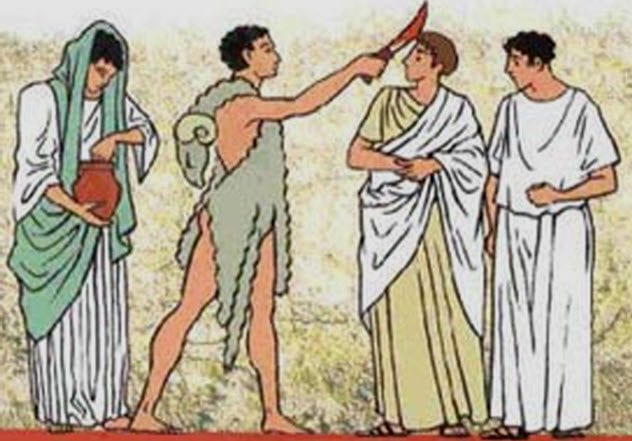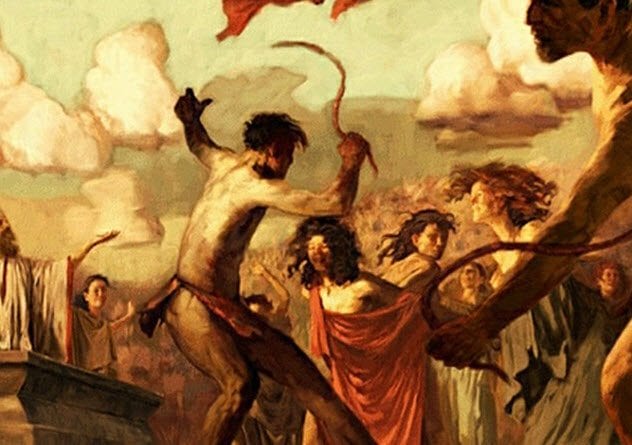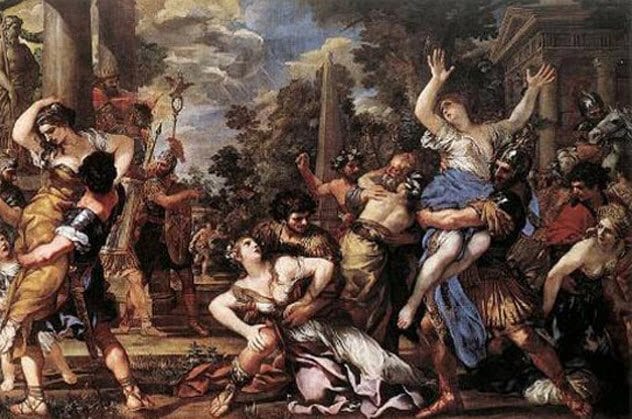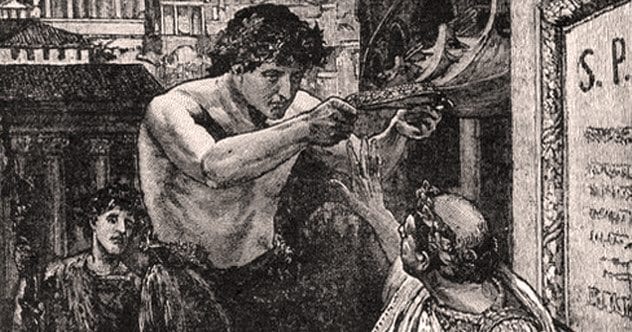 Mysteries
Mysteries  Mysteries
Mysteries  History
History 10 Surprising Stories About the Texas Rangers
 Humans
Humans 10 Philosophers Who Were Driven Mad by Their Own Theories
 Miscellaneous
Miscellaneous 10 Video-Game-Worthy Weapons and Armors from History
 Weird Stuff
Weird Stuff 10 Psychics Who Accurately Predicted Wartime Events
 The Arts
The Arts 10 Pieces of Art Inspired by a Broken Heart
 Health
Health 10 Science Fiction-Sounding New Medical Treatments
 History
History 10 Surprising Facts About the Father of Submarine Warfare
 Space
Space Ten Astonishing New Insights into Alien Worlds
 Weird Stuff
Weird Stuff 10 Bizarre Summer Solstice Rituals Still Practiced Today
 Mysteries
Mysteries Top 10 Haunting Facts About the Ghost Ship MV Alta
 History
History 10 Surprising Stories About the Texas Rangers
 Humans
Humans 10 Philosophers Who Were Driven Mad by Their Own Theories
Who's Behind Listverse?

Jamie Frater
Head Editor
Jamie founded Listverse due to an insatiable desire to share fascinating, obscure, and bizarre facts. He has been a guest speaker on numerous national radio and television stations and is a five time published author.
More About Us Miscellaneous
Miscellaneous 10 Video-Game-Worthy Weapons and Armors from History
 Weird Stuff
Weird Stuff 10 Psychics Who Accurately Predicted Wartime Events
 The Arts
The Arts 10 Pieces of Art Inspired by a Broken Heart
 Health
Health 10 Science Fiction-Sounding New Medical Treatments
 History
History 10 Surprising Facts About the Father of Submarine Warfare
 Space
Space Ten Astonishing New Insights into Alien Worlds
 Weird Stuff
Weird Stuff 10 Bizarre Summer Solstice Rituals Still Practiced Today
10 Bizarre Facts About Lupercalia, The Original St Valentine’s Day
Long before we started giving cards to girls to let them know that we choo-choo-choose them, the Romans were celebrating love in their own way. Every February 15, they held Lupercalia—the original Valentine’s Day.
The holiday has gone through a few changes over the past few thousand years. But don’t worry—if you’re hoping to celebrate a truly traditional Valentine’s Day this year, Listverse has you covered. We’ll let you know everything you need to do.
10 The Murdering Of The Cute Puppies

On the original Valentine’s Day, the Romans kicked off the festivities by dragging two goats and a puppy into a cave and letting a group of cultish priests ritually slaughter them. The instructions were specific about the puppy part. It couldn’t be a mature dog—it had to be an adorable baby puppy.
Even the Romans didn’t really understand why they had to kill a puppy. The best sources we have on the holiday were written centuries after it began. By then, Lupercalia was just an old tradition and the Romans writing about it make it clear that they didn’t understand any of it.
Plutarch was pretty sure that they stole the puppy-killing thing from the Greeks. Based on how Plutarch described them, the Greeks were puppy-killing aficionados. He said that the Greeks killed puppies in rituals so often that they had a word for it: periskulakismoi (“purification by puppy”). This word has also been translated in some real academic papers that people with PhDs were paid to write as “pupprification.”
But even that’s just a theory. By the time Plutarch came around, nobody really knew why they were killing puppies—they were just following tradition. He had another theory, though. Pure spite. “Is it that the dogs bark at the Luperci [priests],” Plutarch theorized, “and annoy them?”
9 The Feigning Of Laughter Of The Blood-Soaked Boys

After the puppies and the goats were killed, two young noble boys were brought into the cave to do something that creeped the hell out of the Christians, who ended up banning this festival.
The priests would touch their knives to the heads of the boys, staining the boys’ heads with blood. Then the priests would dip wool in milk and rub it on the boys’ heads. That was kind of strange, but what really made this unnerving was what came next: With milk and blood streaking down their heads, the boys were required to feign laughter.
Again, the Romans had no idea why they were making creepy, blood-stained children laugh in a dark cave. The Romans believed that it was a purification ritual, but even that was just a theory. It was just a tradition that they’d been following for as long as they could remember, and they weren’t about to break it.
After this, though, came the main event. The priests would make leather thongs out of the goats, the boys would strip naked, and the real games would begin.
8 The Streaking Of The Thong-Carrying Men

“At this time, many of the noble youth and of the magistrates run up and down through the city naked,” Plutarch tells us, “striking those they meet with shaggy thongs.”
These naked men would be covered in oil first. The lower class wasn’t allowed to do this. These were the highest-ranking and most dignified men in the city. People like Mark Antony would strip naked, oil up, and run down the streets.
Once they were good and oily, they’d run around hitting people with shaggy thongs. In particular, they’d target women, who would pretend to run from it. But secretly, the women would try to get hit with the thongs. If you got hit with a thong, the Romans believed, you would become more fertile. So women would bare their backs and offer up their hands in the hopes that naked oily men would whip them.
Those thongs, by the way, were called februare—and they were named before the month. That’s right—the entire month of February is named after magical potency thongs.
7 The Eating Of The Entrails On A Stick

Lupercalia also involved a feast. Although when it came to food, it wasn’t exactly the best holiday. Even Roman poetry calls the feast of Lupercalia “scanty”—and with good cause. The priests would put the entrails of the sacrificed goats on willow spits, cook them up, and feed them to a crowd of people.
Splitting two goats between all the citizens of Rome probably didn’t extend that far, but that wasn’t all they got. Some vestal virgins would also burn salt cakes, which seem to have been something like ancient pancakes. But that was the feast—a tiny bit of goat entrail on a stick and some burned cakes.
None of that might seem particularly appealing, which is probably why the Romans served one more dish: copious amounts of alcohol. For the rest of the day, the people of Rome would be drunk out of their minds.
6 The Hooking Up Of The Swingers

In some parts of Rome, they would take the whole fertility ritual a bit further. Eligible young women hoping to get pregnant would write their names on clay tablets and place the tablets in a jar. Then the men would draw a name at random. Two completely random strangers would be hooked up and be together for the rest of the festival.
Some of the details on this are a bit vague and inconsistent, but it seems like these two weren’t just going on a blind date. The man was there to make the woman’s dream of having a baby a reality. Exactly how long they stuck together seems to vary. Some say they just spent the festival together. But according to others, those two would be sexual partners for the next year.
5 The Airing Of Grievances

Lupercalia had its own songs, too. The lyrics have been lost to time, but we have enough of a description to get a pretty good picture of them. For one thing, we don’t have any records that mention the songs without using the words “licentious” or “obscene.”
At least by the fifth century AD, people at the festival would break into filthy, vulgar songs that described every bad thing their neighbors had done. If you had an affair or got caught at a brothel, your neighbors would come out on Lupercalia and sing a song about your sexcapades for everyone to hear.
The idea was to shame people into good behavior. But as far as the Pope was concerned, the songs tended to come across more as celebrations than criticisms. When they got the chance to talk about what their neighbors had been up to, the Romans apparently got a bit carried away.
4 The Celebration Of The Horny God

Like any good festival, Lupercalia had its classic stories. One was the classic Lupercalia story of Faunus, which Ovid called “an old tale full of laughter.”
Faunus sees Hercules walking with his mistress and declares, “She will be my passion!” This, however, is Rome. So that doesn’t mean he is going to write her love notes and ask her on a date. Instead, he plans on waiting until she’s asleep, sneaking into her house, and going wild.
Faunus sneaks into the girl’s home, unaware that she had covered up Hercules with her own clothes before she went to sleep. So Faunus just starts groping the mound that looks like her clothes. He feels something strange and recoils. As Ovid describes it, someone “will draw back his foot on seeing a snake”—which is more or less what Faunus realized he was grabbing.
Hercules gets up, Faunus falls down, and everyone realizes that Faunus just tried to sexually assault Hercules’s mistress. But nobody gets the slightest bit upset. “Hercules laughed,” Ovid tells us, “as did all who saw him lying there, and the Lydian girl laughed, too.”
According to Ovid, men ran naked on Lupercalia to honor Faunus’s failed attempt at sexual assault. “So the god hates clothes that trick the eye!” Ovid wrote, “and calls the naked to his rites.”
3 The Uncertainty Over Whom You Are Worshiping

The Romans would spend Lupercalia telling stories about Faunus, but he wasn’t actually the god of the holiday. The holiday was called Lupercalia. It was held in Lupercal Cave by Luperci priests. So obviously, it was dedicated to the god Lupercus. The thing is, nobody—including the Luperci priests—actually knew who Lupercus was.
They had a whole cult dedicated to this god, but they didn’t know what he stood for. Lupercalia was an old farming religion. Nobody could remember when the holiday started, let alone why. They were just doing what their parents had done before them.
Their only hint was a statue of a naked man in a goatskin girdle outside Lupercal Cave. The Romans also figured that he probably had something to do with farmers. But that was it—that was all they knew. Lupercus wore a girdle, and that was enough for people to dedicate their lives to being his priests.
2 The Crowning Of Julius Caesar

A major moment in the life of Julius Caesar happened during Lupercalia. When Mark Antony put a wreath on Caesar’s head and offered him the throne, it wasn’t just any day—it was Lupercalia. When you realize that, you realize it went down a bit differently from how you’ve always pictured it.
History specifically states that Caesar was watching the festivities when it happened. But he wasn’t watching people eat; we’re specifically told that he was watching naked, oily, young men run down the streets when Mark Antony came over to offer Caesar the throne.
Unlike Caesar, though, Mark Antony wasn’t just a spectator. He was participating. Plutarch describes him as “one of the runners in the sacred race,” which means that he didn’t walk over to Julius Caesar wearing a tunic. Antony walked over completely naked, holding a shaggy thong in one hand and a laurel wreath in the other.
So, next time your local drama club puts on a production of Julius Caesar, you can make sure they get the costumes right.
1 The Killing Of People Named Valentine

The last Lupercalia was held at the end of the fifth century. By then, Christianity had taken over Rome, and Lupercalia was one of the few Roman holidays that was still being celebrated. Pope Gelasius ended it, though, declaring that it was a pagan ritual full of blood sacrifice that glorified sex.
Most of this ritual had been stopped anyway. Although we don’t know all the details of how it was celebrated in the fifth century, we do know that the Pope challenged the Romans who complained to actually do that “running around naked” part—and none were willing to do it.
The Romans weren’t too happy about losing a festival, though, so a new festival came into existence: St. Valentine’s Day. Well, technically, the Pope replaced Lupercalia with the slightly less popular “Feast of the Purification of The Blessed Virgin Mary,” but eventually, it became Valentine’s Day.
The holiday got the name St. Valentine’s Day because people named Valentine had a strange habit of dying on February 14. Two separate Valentines had already died on that date, so they created St. Valentine’s Day—a day to remember a saint who got beheaded.
Over the next 1,500 years, some things changed. Instead of putting their names in jars, women got cards. Instead of hitting women with girdles, men gave them flowers. But the holiday we celebrate today got its start here.








